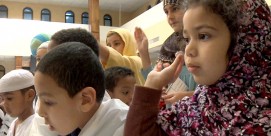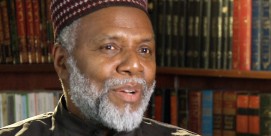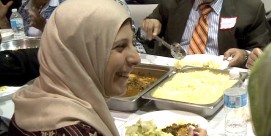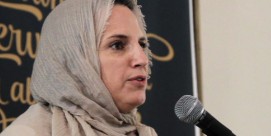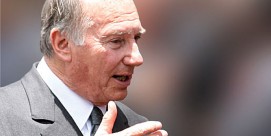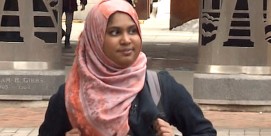In This Episode << SLIDE LEFT TO SEE ADDITIONAL SEGMENTS
Eboo Patel Extended Interview
Read more of Judy Valente’s February 2007 interview with Eboo Patel:
Q: What kind of leaders are you looking for at Interfaith Youth Core?
A: We’re looking for leaders who can make pluralism real in the 21st century. It’s one of the great challenges of our time. Is the 21st century going to be about pluralism, the idea of people from different backgrounds living together in some sort of mutual peace and loyalty, or is the 21st century going to be a battle between different totalitarianisms?

Q: You’ve called these young people social entrepreneurs. What do you mean by that?
A: A social entrepreneur is somebody who knows how to make an idea reality. What we need is a generation of young social entrepreneurs who know how to make that great idea [pluralism] reality in a historical moment where religious extremists are frankly making their idea reality in ways that not only kill dozens and hundreds of people at a time, but in ways that seem so explicit on our television screens. And the danger is that it sometimes seems like that is the only way of living in the world. That’s what the religious extremists want to get across — that the only way of being religious in this world is to destroy diversity. We need a set of young social entrepreneurs dedicated to making pluralism equally real, equally, possibly doubly, attractive — the idea that we can create situations in which people who have very different beliefs, very different backgrounds, very different ideas of belonging, in which they’re moving with each other, hoping that the other community also flourishes. Being creative about that — I think that that’s the biggest challenge of our time.
Q: Who are some of the people who have inspired you?
A: One of my greatest inspirations was a young Lutheran minister named Dietrich Bonhoeffer. Bonhoeffer grew up in Germany, came and studied in the United States in the 1920s and 1930s. He studied at Union Theological Seminary and kind of combined the academic learning that he gained in schools in Germany with the Social Gospel teachings that he saw put into practice in the streets of Harlem in the 1920s and early 1930s. Bonhoeffer returned to Germany at a time when the Nazis were rising in power, and he watched what the Nazis did to Jews in Germany, and he said as a Christian I am called, I am required to stand up against this. And he uttered one of the greatest lines of Christian or religious witness of the 20th century after Kristallnacht, which was the Nazi’s first significant foray in destruction of property in Jewish neighborhoods. Bonhoeffer went on the radio in Germany and said those who did not stand up for the Jews do not deserve to sing Gregorian chants. What that means to me is that there is a religious requirement across the board, I think, in every tradition. Certainly in mine, in Islam, there is a religious requirement that in some cases even is more important than traditional prayer — that, as we say in Islam, God made us to be his abd and khalifa, his servant and representative, on Earth. What that means first and foremost is to make sure that your fellow human beings, whether they are, as Hazrat Ali, the Muslim leader once said, whether they are your brothers in faith or your equals in creation, that your fellow human beings are safe and secure and flourishing. So Bonhoeffer’s example of risking his own life — and he died; Hitler’s last act was ordering the death of Bonhoeffer — [Bonhoeffer’s] saying I am required as a person of faith to stand up for this other community — I think not only do we need to have more of that in this current age, but we need to say even when the jackbooted thugs are not walking around pointing their guns at one particular community — and that happens too many places right now — but even when we live in kind of an uneasy coexistence between groups, as we do in some places in America, we need to say how do we build the bridges of pluralism so strong that when somebody tries to throw a bomb, our bridges can sustain that bomb.
Q: And what about Dorothy Day and the Catholic Worker movement?
A: In a way, I owe my religious awakening to Dorothy Day and the Catholic Worker movement. As a college student I became very politicized. I began asking, why is it that some people have four homes and some people sleep on the streets? Why is it that some people get an exceptional education and other people have to go to kindergarten with 40 other students and never get any personal time of the teacher? And I wanted to answer that question in a way that concretely improved people’s lives, but I also had a vision for a better social system and did everything with large quantities of love.
Q: What was it about the Catholic Worker movement that moved you, inspired you?
A: The thing about the Catholic Worker movement was its combination of concrete service to others, its broad vision of a system in which everybody was safe and secure and flourishing, and its absolute conviction that every relationship, every move that a human being makes, is done with love. And when I inquired at the Catholic Worker — you know, you talk so much about love, where does this love come from — they gave me a three-letter word and that word was God. And it was those conversations at the Catholic Worker that caused my reengagement with the tradition of my birth, which is Islam. I found love initially in the Catholic Worker, and it helped me return and find the deep wells of love and mercy and compassion within my own faith.
Q: You mentioned the other day that religion has been kept out of the discussion of diversity. Why would that be?
A: I think there’s a large segment of America that is still uncomfortable with the religion discussion, and if we remain uncomfortable with the religion discussion then we forfeit the public square to those willing to shout the loudest about religion. And oftentimes those who shout the loudest not only know the least, but they’re the most dangerous and destructive. And their goal, the goal of the Osama Bin Ladens and the Pat Robertsons of the world, is to convince people that there is only one possibility of what it means to be religious or human on Earth, and every other possibility is illegitimate, and the only thing that they — those other ways — are worth is fire and destruction. And if we don’t articulate other ways of being religious, ways that we already believe, if we don’t exhibit those other ways then we can’t say to those dangerous people — if we don’t put our voices in the public square, if we don’t articulate what we think is righteous, what our convictions are about being religious, about living with other people, about the world that we imagine and dream and believe in based in our holy scriptures, then we allow Pat Robertson and Osama Bin Laden and the Christian identity movement to dominate. We allow them to say [they] are the only possibility, and then I think what you have is a world of religious totalitarians and a world of aggressive secularists, and the religious people are saying see those other people, the secularists? They want to banish God from everything, and we’re the only option. If you are religious I am the only option. And what the secularists are saying is, look at what the Osama Bin Ladens and Pat Robertsons are doing. Why don’t we just jettison everything religious? But there is a third way, and that third way is pluralism. That third way says deep in my heart, deep in my God-consciousness, deep in my scripture is the idea that I am meant to live with you. We are meant to make it together. That’s the idea that we want to put in culture.
Q: You’ve said young people have the power to destroy or to create. Tell me what you mean by that.
A: There’s a great line from the poet Gwendolyn Brooks, speaking as if she were a young person. She says, “I shall create! If not a note, a hole / If not an overture, a desecration” [“Boy Breaking Glass”]. I was a teenager not too long ago, and what I remember the most about being a teenager was being talked down to by everybody. I remember feeling thoroughbreds galloping through my heart, feeling like what I wanted to do was make an impact, and I had energy coming out of every pore in my body, and I wanted to somehow make that energy move the world. And so many people around me were saying, you know, keep your head down, just do what you’re supposed to do, you don’t know anything yet. And I feel like, had somebody come up to me and said I have the key for you to move the world, and if that person had said this key will allow you to change the course of history and all you have to do is pull the trigger or push the button, I feel like a lot of teenagers, because of their desire to make an impact, might somewhere in their being be slightly attracted to that. They have no interest in destruction for destruction’s sake, but they want to make an impact. I believe that’s how God made us. He made us so that we could move the world. Why aren’t the people who have a dream of pluralism, why aren’t the people who have a dream of a world where people are working together, why aren’t we giving young people the key to make that type of an impact? Why is our message to young people generally hey, why don’t you design the t-shirt for the annual conference, or why don’t we have a separate youth program, which everybody knows is just really kind of kids camp? You know, why aren’t we saying 16-year-olds and 18-year-olds and 22-year-olds, we’re going to invest in you not because you’re the leaders of tomorrow, but because you’re the leaders of today, and because in a really profound way the success, the survival of all of us depends on you?
Q: There are people who can hear your message and say this man doesn’t want people to really practice their religion. He wants everybody to find commonalities, and in fact he might be a threat to the practice of the Christian religion or the Muslim religion. How do you explain the balance you are talking about, about having shared values but also keeping the core values, the uniqueness of your own religion?
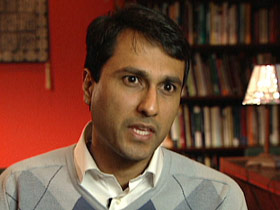
A: In the Holy Qur’an it says that God made us into different nations and tribes that we may come to know one another. I take that command, that vision very, very seriously — that people are different, that Islam and Christianity and Judaism have significant, profound differences. I as a Muslim believe deeply in the differences that are within Islam. But I also take seriously the idea that we have to come to know one another. I have learned so much more about Islam in conversation with Jews and Christians and Hindus. I feel like that is part of the beauty of life on Earth — that we discover and develop what it means to be Muslim or Christian or Jewish not in isolation from others, but precisely in relationship with others. And I believe the Qur’anic messages — that is how God meant it to be. So when people say, but our children — they don’t even really know what it means to Jewish or Christian yet so I’m uncomfortable putting them in an interfaith situation. My response is, I understand where you’re coming from. I’m sensitive to that concern and that sentiment. But the question is not only what does it mean to be Christian; it is also what does it mean to be Christian in the early 21st century in a world of passionate religiosity and intense interaction? To teach your child to only be a Muslim in Muslim spaces or only a Christian in Christian spaces means in a way that you’re teaching them a religious identity that is relevant to only a very small part of their lives, because the vast majority of their lives in the 21st century are going to be lived in interaction with others, and a big part of what the Interfaith Youth Core is about is to guide what that interaction might look like. I think that there is a private dimension to religiosity, and I think that there’s a public dimension to religiosity. One of the reasons we don’t talk much about prayer or questions of salvation at the Interfaith Youth Core is we believe those are part of the private dimension. But the public dimension is what we can do together and that I think all religious communities can profitability be a part of. In fact, I’m convinced it strengthens religious identities.
Q: One could hear what you have to say and believe it’s terribly naïve. You mentioned the other day that by focusing on shared values and commonality people come together. But, in fact, in places like Bosnia people lived side by side for many years but it still erupted into violence. How do you respond to that possible criticism, that your vision is naïve?
A: I used to take being called naïve as a significant insult. I take that less and less as an insult. One of the reasons is because in religious traditions the very idea of having a dream for something better is — there’s actually a dimension of holiness around it. So Jesus in some Christians’ thinking is called the holy fool. There’s a wonderful line in the work of the Muslim poet Rumi that says start a huge foolish project like Noah. And Noah’s huge foolish project, according to religious scripture, saved the world. And so I dream of a world where people from different backgrounds are praying and working for the flourishment of communities different from them, and I find my sustenance not only in these stories in scripture, but in stories of human existence also — the story of the Bosnian Muslim man who took to a Serbian couple with a new baby a liter of milk every day during that horrible struggle in the former Yugoslavia, because he said even if our tribes, our nations, are at war with each other, there is something deeply human about me wishing that your baby survives and is secure. And several years later when a journalist found that Bosnian Muslim man shivering in a coat too thin in the winter, selling rotten apples out of a push cart, his first question to the journalist was, how’s the baby doing? I find in those examples such deep humanity that when people say to me Eboo, your vision is naïve, I say yes, but it is not only naïve, because there are enough times when the human condition has transcended tribalism and chosen compassion and chosen pluralism that I think if we build on those examples we will have a world we are proud to show our creator.
Q: Could you also explain what you mean when you say the color line was the main division of the 20th century, and the faith line will be the main fault line of the 21st century?
A: I believe we are light years away from fully solving, even fully addressing the challenge of the color line. But I think that what we have seen thus far of the 21st century says to us that we’ve inherited an additional line, the faith line. The big question is who does the faith line divide? And too many people think that the faith line divides Muslims and Christians or Jews and Hindus, or just to say that there is this clash of civilizations and people from different religions are inevitably against each other, inherently opposed to each other. I don’t believe that for a second. I think the faith line divides totalitarians and pluralists, which is to say that totalitarians from different religious backgrounds, although they might tear each other’s eyes out if you put them in a room together — Osama Bin Laden and Pat Robertson — the truth is they’re standing shoulder to shoulder, arm and arm on the same side of the faith line against the dream of a common life together. The totalitarians in the world are very, very small. Only the smallest part of humanity wishes and acts upon the destruction of others. The pluralists are far larger. Those of us who believe in a world where we live together — we’re far larger. The problem is we haven’t made our case compelling across the world yet. We haven’t articulated what pluralism means in a cogent enough manner, and I think the vast majority of the world is standing on the faith line, and the totalitarians understand that, and they’re going after those people standing on the faith line, particularly the young people, and they’re saying our way is the only way possible; join us or you will be lost and destroyed. What we pluralists have to do is to say to the people standing on the faith line, particularly the young ones, no, pluralism is the wish of the creator. It is the greatest opportunity for humanity. We now just have to make it real.
Q: How do you spread that message abroad?
A: I think that we live in a remarkably networked world. The problem with that, of course, is that tensions can travel in nanoseconds across the Internet, and so the tensions between Shiites and Sunnis in Baghdad, or between Protestants and Catholics in Belfast — those show up in different parts of the world. But if tensions can travel, then possibilities can travel also, then cooperation can travel, then pluralism can travel, and young people are the most highly networked of all people on Earth. They’re the most fluent in contemporary technology. So what if we had young people all over the world — and this is precisely what the Interfaith Youth Core is setting up — working with young social entrepreneurs all over the world to say what are you doing to make pluralism real? How are you bringing people together? We’ve got people in Europe. We’ve got people in Jordan. We’ve got people in Nigeria. We’ve got people in South Africa. We’ve got people here in the United States, people in Mexico saying, here’s how I’m doing it. The Interfaith Youth Core is committed to networking them and committed to launching this idea into global culture, that people standing together bridging their differences, seeking a newer world with one another — we are far stronger. We are far more attractive. We are far more desirable than those who wish only fire and brimstone.
Q: Where do you see your movement in five years?
A: I hope the Interfaith Youth Core is successful working with others in making pluralism the great idea of our time. If you were to have asked somebody 100 years ago what is human rights, they might not have know. But Amnesty International and Human Rights Watch and a number of great organizations have made human rights a big idea, and everybody in some way or another understands the importance of human rights and thinks they can participate in making it real. We need to do the same thing for pluralism, particularly religious pluralism, and we need to say to the world it is young people who have the most vibrant ways of making religious pluralism real. Let’s watch those young people. Let’s invest in them, and then let’s follow them.
Q: What makes you think the experience of pluralism and interreligious work that you give young people will stick with them after they graduate from high school or college? How can they continue on with it in their lives?
A: I think that young people are going to continue on with the work on pluralism for two reasons, really. One is because it’s the reality of the world that they live in, and I think young people from different backgrounds are asking themselves, what does it mean for me to be a Buddhist and friends with a Baptist? And they want ways of making that connection, and the Interfaith Youth Core is providing them with a way of thinking and a set of tools. And so once you help young people develop that paradigm they’ll stick with it. But I think that there’s a deeper reason also. I think that this is what God meant for humanity, and we Muslims believe that there is the breath of God in all of us. And I feel like when you provide somebody with a real example that connects with what is part of their deepest nature, they say to themselves somewhere in a place far into their heart, that’s what I want to be about, because that’s what I was meant to be.

Q: So you think they can continue on with this as they go into the professions and the business world?
A: Absolutely. You know, Catholic choir boys sometimes becomes cardinals, sometimes become popes. Little children in Qur’an schools and Hebrew schools sometimes grow up to lead great Muslim organizations or great Jewish organizations. Sometimes they become governors. Sometimes they become presidents. And what we need to do is invest young people with an idea of pluralism now, and they put it into practice where they’re at, but in 10, 20, 30, 40 years when they’re in different positions they’ll put it into practice then also. And I think in some ways we see some of the largest fruits of the work of investing in young people in a half-century. I mean, I think about the people who invested in Martin Luther King Jr. or Pope John Paul II when they were children, and the work that those two did as adults changed the 20th century. It’s the same thing the Interfaith Youth Core is trying to do with our generation of faith heroes in the 21st century.
Q: Can you comment on the Jordan project and its significance?
A: The big idea of the Jordan project is that there are social entrepreneurs building religious pluralism all over the world, and what we have to do is start connecting those people. And Jordan, India, and South Africa and Kenya, the United States — there are different versions of pluralism in each of these countries. And sometimes people in different parts of the world think that their way of getting along, their way of cooperating, is the only way of cooperating. What we have to let people know is actually pluralism has many colors. It has many different stripes, and it is absolutely exhilarating when you bring one group of young people who are building interfaith cooperation in one way together with a group of young people building interfaith cooperation in a different way to share their world views, to share their methods. That’s exactly what happened when these young Americans went to Jordan in January. That’s exactly what’s going to happen when these young Jordanians come to America in a couple of months. This international interfaith youth exchange with Jordan is a great example of the multiplier effect of the Interfaith Youth Core. Six or seven years ago, when we were just starting, I got an email out of the blue from a young Jordanian named Anas, and he said I found your Web site, and I really want to learn more about interfaith youth cooperation. Can you email me some tools? And so we emailed him some of the Interfaith Youth Core material. We gave him some ideas of what to do. And I didn’t — I kind of lost touch with this guy. Then a couple of years ago Queen Rania of Jordan heard about the Interfaith Youth Core and invited me to come and to do some work in Jordan. And I decided, well, you know, I’ll look up my old friend Anas. I haven’t heard from him in five years; let’s see what he’s up to. He could have been an engineer or an accountant for all I knew. It turns out Anas had started several interfaith youth groups in Jordan. Anas had started something called the Jordanian Youth Forum, which had got the attention of the King and the Queen of Jordan. He had led several interfaith youth cooperation trips between the Middle East and Europe. I was astounded by this range of work, and I said Anas, how did you start? He said the Interfaith Youth Core. I started with those conversations with you over email, and then the material that you sent us, you know, we ran the projects that you guys suggested, and then we developed kind of our own way of running them, kind of a Jordanian approach to interfaith youth cooperation, and now this movement is flourishing in Jordan. I couldn’t believe it. I just thought to myself, my gosh, this could happen all over the world. This idea, interfaith youth cooperation — it’s relevant to so many young people in some parts of the planet, and the goal of the Interfaith Youth Core is to catalyze that and to resource it and then to network it — and when we do, watch out.
Q: What happens when you are no longer the head of the Interfaith Youth Core, when you begin aging and you are no longer young?
A: When I’m no longer the head of the Interfaith Youth Core, then the thousands of people who are better at this than me, who are smarter than me, they’ll do what they’ve always done, which is make interfaith youth cooperation happen in their communities in ways both big and small, and network all over the world. I happen to be in the position I’m in right now. It is an absolute blessing, but what inspires me is watching how this happens all over the world. I have no concerns and no worries about if I am no longer doing this tomorrow or ten years from now. My hope is that God gives me the blessing of doing this, for as long as it is right for me and for this movement, to be in this position.
Q: What about the service element of your program?
A: One of the best ways of making the core values of compassion and justice and stewardship that are in all of our religious traditions real is to do service, is to do an Earth Day project, is to do a Habitat for Humanity project. One of the best ways of showing pluralism in action is for people to do service together, and that has so many benefits. It benefits each of us individually because we’re living out the ethic of our religious traditions. It benefits the world because of the concrete service being done. But I think that there’s also a benefit in the realm of what I call possibility, the realm of imagination. Religious extremists want to show us that the only possibility is for us to kill each other, so September 11 is not only heinous murder, it is also global performance. It is also putting an idea into the world, an idea of destruction. When you have images of young people from different religions coming together to serve others, you’re putting a different idea into the culture. You’re opening up people’s imagination to say, oh that’s what young Muslims and Jews and Christians and Buddhists and Jews can do together. It doesn’t always have to be fighting. It doesn’t always have to be ignoring or hating one another. It can be serving with one another. It can be benefiting the planet. That’s pluralism in action.
Q: What is the difference between interfaith youth councils and the Interfaith Youth Core?
A: The Interfaith Youth Core is the heart of a movement, and the real movement happens all around us, in every country every day when young people make interfaith youth cooperation a reality. What we try to do here is pilot a set of projects that we think will be useful elsewhere. Interfaith youth councils are one idea. Days of Interfaith Youth Service are a second idea. Then we develop curriculum and training materials based off of the best practices we’ve observed, and we try to spread those around the world. The one big project that we coordinate is called the Days of Interfaith Youth Service, and it happens in late April of every year, when campuses and communities and cities say for this weekend, for this one afternoon, we’re going to bring together our young people from different religious communities, and they’re going to build houses, they’re going to tutor children, they’re going to clean parks and rivers together. They’re going to talk about what it is in their faith tradition that inspires them to serve others and inspires them to cooperate. That’s a program that we coordinate, and right now it’s in 50 cities and campuses, but I see no reason why it can’t be 500 or 5,000 or 50,000.
Q: And the youth councils?
A: The youth council is another project, so we oftentimes — a campus or a city, their first interfaith youth project will be to run a Days of Interfaith Youth Service inspired by the Interfaith Youth Core, based off of our curriculum, and then they’ll say this was great, what can we do on a more consistent basis? And then we suggest to them, well, why don’t you run an interfaith youth council or have several interfaith youth councils in your city? And we have a set of training materials and a curriculum and some media materials that help them do that also. So the Interfaith Youth Core is the bigger organization [and] the heart of the movement, and the movement is happening at Harvard, and it’s happening in Amman, Jordan, and it’s happening in Bombay, India, and it’s happening when young people start their own Days of Interfaith Youth Service or start their own interfaith student council and connect back with us and say, hey, here’s how we’re doing it. Why don’t you spread our way to the world?

